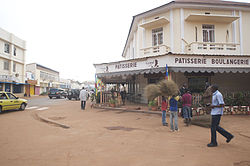Bangui
Bangui is the capital city of Central African Republic. It is the largest city in the country. The city has a population of 531,763 people. Most of the population of the Central African Republic lives in the western parts of the country, near Bangui.
 | |
 Map of the Central African Republic showing Bangui | |
| Coordinates: 4°22′N 18°35′E / 4.367°N 18.583°ECoordinates: 4°22′N 18°35′E / 4.367°N 18.583°E | |
| Country | |
| Prefecture | Ombella-M'Poko |
| Government | |
| • Mayor | Jean-Barkes Gombe-Kette |
| Area | |
| • Total | 67 km2 (26 sq mi) |
| Elevation | 369 m (1,211 ft) |
| Population (2006) | |
| • Total | 622,771 |
| • Density | 9,295.1/km2 (24,074/sq mi) |
History
The city was founded in 1889 in what was then the French colony Haut-Oubangui ('Upper Ubangi'). The colony was later renamed Oubangui-Chari and made part of French Equatorial Africa. The city grew around the French military post on the Ubangi river.[1] Bangui served as an administration center for the colony and is now the administrative center of the CAR.
Much violence in Bangui came after the March 1981 elections. These elections took place after the French removed Jean-Bedel Bokassa from office and replaced him with David Dacko. People who did not like Dacko attacked Bangui and made Dacko leave the country. Andre Kolingba then formed the Comité Militaire pour le Redressement National.
About 200 Central African Republic soldiers mutinied in Bangui in May 1996. They wanted back pay and for dictator Patassé to be removed from control of the country. French soldiers in the country stopped them and returned Patassé to power. More than 50 people were killed during this time.
Geography and Climate
Bangui is on the northern banks of the Ubangi River. It is just below a series of rapids. The Congolese town of Zongo is on the opposite side of the river from Bangui. The city centre is near the river. It has a large triumphal arch, the Presidential Palace and the central market. North of the city lie rolling hills.
The Central African Republic is just north of the Equator. Because of this, the daily high temperatures rarely fall below the high 80s Fahrenheit.[2] The rainy season lasts from May until October. Bangui, being in the south of the country and closest to the Equator, is slightly hotter and wetter than the northern parts of the country.[3]
Economy
Bangui is an administrative, trade, and commercial center. Bangui makes textiles, food products, beer, shoes, and soap. The main exports are cotton, timber, coffee, and sisal. Unemployment in the city was near 23% as of 2001.
Transportation
Bangui is a river port. It is served by Bangui M'Poko International Airport. The port handles the most of the country's trade with other countries. River ferries sail to Brazzaville and Zongo. Roads connect the city to Cameroon, Chad, and Sudan.
Culture
Several periodicals and three daily newspapers publish in Bangui. Other things to see in Bangui include Boganda Museum and Bokassa Palace.
Education
Bangui is home to the University of Bangui. It was founded in 1970.[4] The University of Bangui is the only non-agricultural college in the Central African Republic.
Notes and references
- ↑ "World66 - Bangui travel guide". Archived from the original on 2013-12-31. Retrieved 2007-06-09.
- ↑ "BBC - World Weather - Average Conditions - Central African Republic". Archived from the original on 2007-10-21. Retrieved 2007-06-09.
- ↑ "Lonely Planet Destination Guide - Bangui Weather". Archived from the original on 2022-06-15. Retrieved 2007-06-09.
- ↑ "University of Bangui Official Site". Archived from the original on 2012-02-16. Retrieved 2007-06-09.
| Wikimedia Commons has media related to Lua error in Module:Commons_link at line 62: attempt to index field 'wikibase' (a nil value).. |
Bangui Media
Ubangi (Oubangui) River at the outskirts of Bangui.







